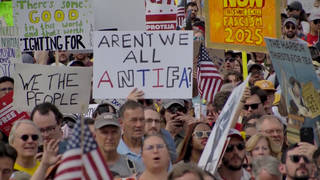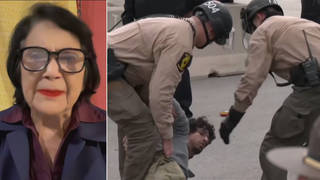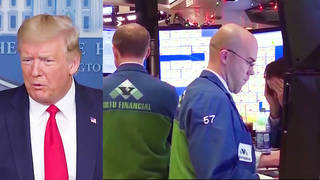
Topics
Guests
- John Dunbarsenior fellow at the Center for Public Integrity. His latest article is titled ”Subprime Players Get Tax Money to Fix Subprime Mess”
A new report by the Center for Public Integrity has found that any of the lenders that helped fuel the housing crisis by issuing risky subprime loans are now lining up to receive more than $21 billion in taxpayer money intended to help bail out borrowers. At least twenty-one out of the top twenty-five participants in the Making Home Affordable program specialized in servicing or originating subprime loans. [includes rush transcript]
Transcript
JUAN GONZALEZ: We turn to a new report from the Center for Public Integrity that turns the spotlight on President Obama’s massive foreclosure prevention program. Many of the lenders that helped fuel the housing crisis by issuing risky subprime loans are now lining up to receive more than $21 billion in taxpayer money intended to help bail out borrowers. At least twenty-one out of the top twenty-five participants in the Making Home Affordable program specialized in servicing or originating subprime loans, the report says.
The funds come from the government’s $75 billion Home Affordable Modification Program, or HAMP, which gives lenders taxpayer subsidies to lower mortgages that might otherwise end in foreclosure.
President Obama announced the details of the administration’s homeowner assistance plan at a speech in Phoenix in February.
PRESIDENT BARACK OBAMA: But I want to be very clear about what this plan will not do. It will not rescue the unscrupulous or irresponsible by throwing good taxpayer money after bad loans. It will not help speculators — it will not help speculators who took risky bets on a rising market and bought homes, not to live in, but to sell. It will not help dishonest lenders who acted irresponsibly, distorting the facts — distorting the facts and dismissing the fine print at the expense of buyers who didn’t know better. And it will not reward folks who bought homes they knew from the beginning they would never be able to afford.
AMY GOODMAN: Well, six months later, the Washington, DC-based investigative non-profit, the Center for Public Integrity, has a new analysis showing how the government is paying subprime players billions to fix the housing mess they helped create. This report is a follow-up to an earlier one that identified the top twenty-five subprime lenders and their financial backers, many of which were financial firms that received TARP funds through other federal programs.
For more on all this, we’re joined now from Washington, DC by the Center’s John Dunbar, the head author of the report.
John, welcome to Democracy Now! Lay out your findings.
JOHN DUNBAR: Well, as you mentioned, the first report was to try to identify the top twenty-five subprime lenders during that huge real estate bubble, which was in ’05, in ’04, ’05, ’06, ’07. After that report was completed, I started looking at the Treasury reports on dispensation of the TARP funds, basically the Troubled Asset Relief funds, which are the taxpayer bailout money. And I was intrigued by the fact that these were payouts or direct incentives to lenders to encourage them to participate in this program, but I wasn’t seeing much written about these companies, who they were, and the fact that this was — like I said, it’s a straight payout. These are incentives, not like the other TARP programs where we’re making an investment in a bank and we actually might get some of it back.
So I started digging into who the top participants in the program were. And there was a sort of a disconnect that seemed to develop between what we were seeing in the coverage and what, you know, the program actually was. It seemed like what we were hearing from the White House was that we were — the White House was pressuring these servicers to get with the program, but what I wasn’t seeing was much coverage of what the program actually is, who’s participating, and what the backgrounds of these companies were. So we started to take a look at what these, you know, potential payments — and I stress these are —- I don’t believe any money has actually gone out yet. These are basically caps, the most amount of money that will go out, that will go to these various loan servicers. And, you know, I was really -—
AMY GOODMAN: Name names, John. Go down the list.
JOHN DUNBAR: Well, I was really stunned at who was — basically, who were at the top of the list. They’re actually pretty familiar. Number one was Countrywide, which was very unusual to see that listed as a recipient of bailouts, because Countrywide was sold, and it’s now owned by Bank of America. That immediately said a lot about what the quality of the loans that we’re talking about.
You know, if — well, I’ll name some more names for you. Another one that was on the list, you know, as we go down — and I’ll just work my way down — JPMorgan Chase also qualifies. JPMorgan had a — well, Chase Home Finance was a subprime lender that was on our subprime list. Wells Fargo was number three. Wells Fargo was number eight on the Center’s subprime list.
AMY GOODMAN: At $2.4 billion. JPMorgan Chase at $2.7 billion. Countrywide at $5.2 billion?
JOHN DUNBAR: Right, and the — because Countrywide also bought Merrill Lynch, which owned a couple of other subprime loan subsidiaries, that total that they could actually collect would be closer to $6.9 billion. And I should stress that that’s not just money straight — that goes directly to the servicer. The program also includes payments to the lender itself and also money to the borrower, which goes actually not to the borrower, but to the bank to pay down principal on the loan.
JUAN GONZALEZ: John Dunbar, how exactly did the program — does the program work? I mean, the lenders get cash payments from the federal government to do what? Are they reducing principal or interest or the actual payments? Explain the mechanics of it.
JOHN DUNBAR: Well, this was pulled pretty much straight out of a similar program at IndyMac, which was a giant bank failure, savings and loan failure in California. And when the FDIC took over IndyMac and instituted this loan modification program, where — what the gist of it is, is it’s not about principal; it’s actually about dropping interest rates and then deferring interest payments, which I think is something else that sort of gets lost in the conversation here, where your payment schedule — rather than eliminating the principal and thereby, you know, cramming down the loan or the value of the loan or the amount of the loan, basically what you’re doing is extending the payments over a much longer period. That’s what they call the amortization schedule, which can go on for as long as forty years. So what happens is, the lender will drop the amount of your payments to 38 percent of your monthly income, and then the government steps in and helps them knock it down even further, down to 31 percent.
Now, I also stress that there has to be a calculation made that a modification would be a better investment for the owners of the loans than an actual foreclosure. So they do that comparison, and if it looks like a modification is going to be better, then they go the modification route.
JUAN GONZALEZ: But —-
JOHN DUNBAR: As far as the -— I’m sorry, go ahead.
JUAN GONZALEZ: So, in other words, what you’re saying is that there is no actual interest forgiven, nor does — if you have a house that is worth a lot less, significantly less, than when you bought it, your principal is not reduced; it’s just that your payments are extended over a longer period of time? They’re reduced, but they’re — you still got to pay the same amount of the loan, just over a longer period of time.
JOHN DUNBAR: Yeah, there’s — initially. There are some interesting aspects in the Obama program that do try to address those areas, because these are not new issues. If, for example, you get down to the 31 percent and you’re still having problems, or you can’t get to the 31 percent and you have to knock down principal, then, yeah, that’s possible. The problem with that is, is, you know, how likely is it — how are you going to get to the point to where you are lowering principal? There’s also a $10 billion program which will hopefully address this — what I think is the nut of the entire foreclosure problem, and that is that people have $500,000 loans for $300,000 homes. You know, their motivation to continue paying in that scenario is not high.
AMY GOODMAN: Well, John, we’re going to leave it there. John Dunbar, Center for Public Integrity, lead author on the report that we will link to at democracynow.org.
When we come back, a Wells Fargo whistleblower. She was in charge of giving out subprime loans. Now she’s talking about what she did and talking about her deep concerns about Wells Fargo.












Media Options